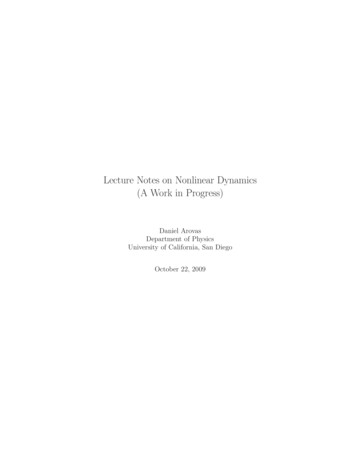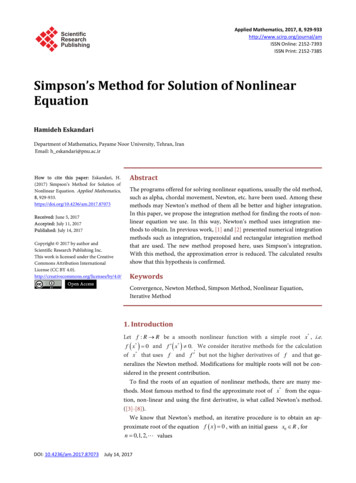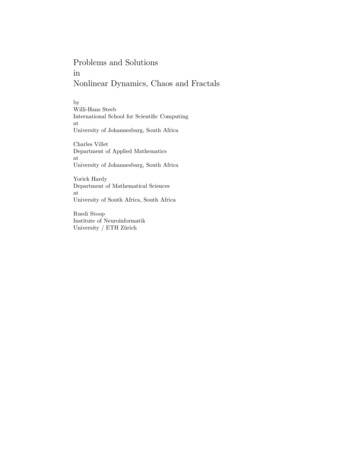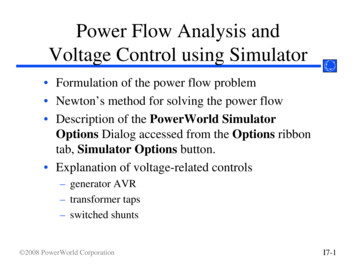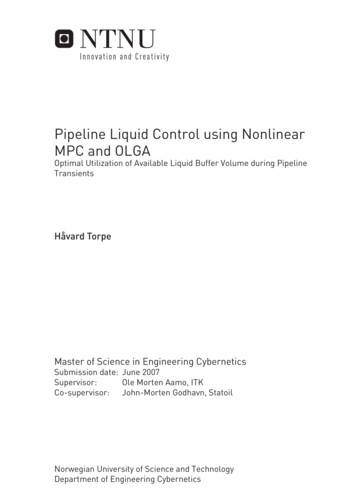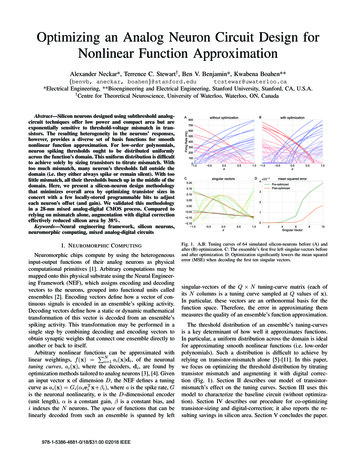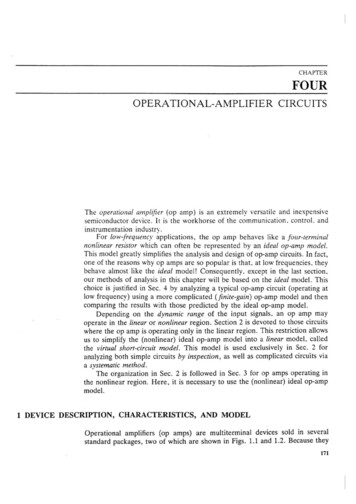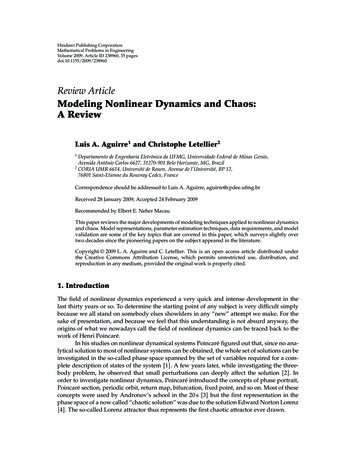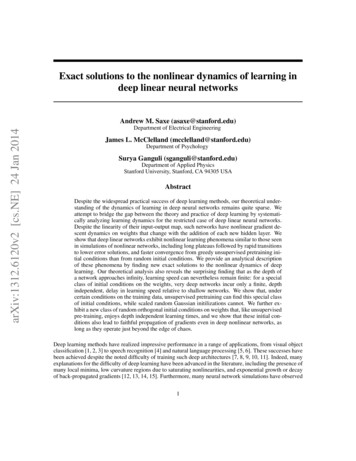
Transcription
Exact solutions to the nonlinear dynamics of learning indeep linear neural networksarXiv:1312.6120v2 [cs.NE] 24 Jan 2014Andrew M. Saxe (asaxe@stanford.edu)Department of Electrical EngineeringJames L. McClelland (mcclelland@stanford.edu)Department of PsychologySurya Ganguli (sganguli@stanford.edu)Department of Applied PhysicsStanford University, Stanford, CA 94305 USAAbstractDespite the widespread practical success of deep learning methods, our theoretical understanding of the dynamics of learning in deep neural networks remains quite sparse. Weattempt to bridge the gap between the theory and practice of deep learning by systematically analyzing learning dynamics for the restricted case of deep linear neural networks.Despite the linearity of their input-output map, such networks have nonlinear gradient descent dynamics on weights that change with the addition of each new hidden layer. Weshow that deep linear networks exhibit nonlinear learning phenomena similar to those seenin simulations of nonlinear networks, including long plateaus followed by rapid transitionsto lower error solutions, and faster convergence from greedy unsupervised pretraining initial conditions than from random initial conditions. We provide an analytical descriptionof these phenomena by finding new exact solutions to the nonlinear dynamics of deeplearning. Our theoretical analysis also reveals the surprising finding that as the depth ofa network approaches infinity, learning speed can nevertheless remain finite: for a specialclass of initial conditions on the weights, very deep networks incur only a finite, depthindependent, delay in learning speed relative to shallow networks. We show that, undercertain conditions on the training data, unsupervised pretraining can find this special classof initial conditions, while scaled random Gaussian initilizations cannot. We further exhibit a new class of random orthogonal initial conditions on weights that, like unsupervisedpre-training, enjoys depth independent learning times, and we show that these initial conditions also lead to faithful propagation of gradients even in deep nonlinear networks, aslong as they operate just beyond the edge of chaos.Deep learning methods have realized impressive performance in a range of applications, from visual objectclassification [1, 2, 3] to speech recognition [4] and natural language processing [5, 6]. These successes havebeen achieved despite the noted difficulty of training such deep architectures [7, 8, 9, 10, 11]. Indeed, manyexplanations for the difficulty of deep learning have been advanced in the literature, including the presence ofmany local minima, low curvature regions due to saturating nonlinearities, and exponential growth or decayof back-propagated gradients [12, 13, 14, 15]. Furthermore, many neural network simulations have observed1
strikingly nonlinear learning dynamics, including long plateaus of little apparent improvement followed byalmost stage-like transitions to better performance. However, a quantitative, analytical understanding of therich dynamics of deep learning remains elusive. For example, what determines the time scales over whichdeep learning unfolds? How does training speed retard with depth? Under what conditions will greedyunsupervised pretraining speed up learning? And how do the final learned internal representations dependon the statistical regularities inherent in the training data?Here we provide an exact analytical theory of learning in deep linear neural networks that quantitativelyanswers these questions for this restricted setting. Because of its linearity, the input-output map of a deeplinear network can always be rewritten as a shallow network. In this sense, a linear network does not gain expressive power from depth, and hence will underfit and perform poorly on complex real world problems. Butwhile it lacks this important aspect of practical deep learning systems, a deep linear network can nonethelessexhibit highly nonlinear learning dynamics, and these dynamics change with increasing depth. Indeed, thetraining error, as a function of the network weights, is non-convex, and gradient descent dynamics on thisnon-convex error surface exhibits a subtle interplay between different weights across multiple layers of thenetwork. Hence deep linear networks provide an important starting point for understanding deep learningdynamics.To answer these questions, we derive and analyze a set of nonlinear coupled differential equations describinglearning dynamics on weight space as a function of the statistical structure of the inputs and outputs. Wefind exact time-dependent solutions to these nonlinear equations, as well as find conserved quantities in theweight dynamics arising from symmetries in the error function. These solutions provide intuition into howa deep network successively builds up information about the statistical structure of the training data andembeds this information into its weights and internal representations. Moreover, we compare our analyticalsolutions of learning dynamics in deep linear networks to numerical simulations of learning dynamics indeep non-linear networks, and find that our analytical solutions provide a reasonable approximation. Oursolutions also reflect nonlinear phenomena seen in simulations, including alternating plateaus and sharp periods of rapid improvement. Indeed, it has been shown previously [16] that this nonlinear learning dynamicsin deep linear networks is sufficient to qualitatively capture aspects of the progressive, hierarchical differentiation of conceptual structure seen in infant development. Next, we apply these solutions to investigatethe commonly used greedy layer-wise pretraining strategy for training deep networks [17, 18], and recoverconditions under which such pretraining speeds learning. We show that these conditions are approximatelysatisfied for the MNIST dataset, and that unsupervised pretraining therefore confers an optimization advantage for deep linear networks applied to MNIST. Finally, we exhibit a new class of random orthogonal initialconditions on weights that, in linear networks, provide depth independent learning times, and we show thatthese initial conditions also lead to faithful propagation of gradients even in deep nonlinear networks, aslong as they operate just beyond the edge of chaos.1General learning dynamics of gradient descentWe begin by analyzing learning in a three layer network (input, hidden, and output) with linear activation functions (FigW 21W 321). We let Ni be the number of neurons in layer i. The input3221output map of the network is y W W x. We wishto train the network to learn a particular input-output mapfrom a set of P training examples {xµ , y µ } , µ 1, . . . , P .y RNx RNh RNTraining is accomplished via gradient descent on the squaredPP2error µ 1 y µ W 32 W 21 xµ between the desired feature output, and the network’s feature output. This gradient Figure 1: The three layer network analyzedin this section.3221
descent procedure yields the batch learning rule W 21 λPXW 32T y µ xµT W 32 W 21 xµ xµT , W 32 λµ 1PX Ty µ xµT W 32 W 21 xµ xµT W 21 ,µ 1(1)where λ is a small learning rate. As long as λ is sufficiently small, we can take a continuous time limit toobtain the dynamics, ddTT(2)τ W 32 Σ31 W 32 W 21 Σ11 W 21 ,τ W 21 W 32 Σ31 W 32 W 21 Σ11 ,dtdtPPPPwhere Σ11 µ 1 xµ xµT is an N1 N1 input correlation matrix, Σ31 µ 1 y µ xµT is an N3 N1input-output correlation matrix, and τ λ1 . Here t measures time in units of iterations; as t varies from 0to 1, the network has seen P examples corresponding to one iteration. Despite the linearity of the network’sinput-output map, the gradient descent learning dynamics given in Eqn (2) constitutes a complex set ofcoupled nonlinear differential equations with up to cubic interactions in the weights.1.1Learning dynamics with orthogonal inputsOur fundamental goal is to understand the dynamics of learning in (2) as a function of the input statisticsΣ11 and input-output statistics Σ31 . In general, the outcome of learning will reflect an interplay betweeninput correlations, described by Σ11 , and the input-output correlations described by Σ31 . To begin, though,we further simplify the analysis by focusing on the case of orthogonal input representations where Σ11 I.This assumption will hold exactly for whitened input data, a widely used preprocessing step.Because we have assumed orthogonal input representations (Σ11 I), the input-output correlation matrixcontains all of the information about the dataset used in learning, and it plays a pivotal role in the learningdynamics. We consider its singular value decomposition (SVD)PN1TΣ31 U 33 S 31 V 11 α 1sα uα vαT ,(3)which will be central in our analysis. Here V 11 is an N1 N1 orthogonal matrix whose columns containinput-analyzing singular vectors vα that reflect independent modes of variation in the input, U 33 is an N3 N3 orthogonal matrix whose columns contain output-analyzing singular vectors uα that reflect independentmodes of variation in the output, and S 31 is an N3 N1 matrix whose only nonzero elements are on thediagonal; these elements are the singular values sα , α 1, . . . , N1 ordered so that s1 s2 · · · sN1 .21T32Now, performing the change of variables on synaptic weight space, W 21 W V 11 , W 32 U 33 W ,the dynamics in (2) simplify tod 21d 3232 T3221322121 Tτ W W(S 31 W W ),τ W (S 31 W W )W.(4)dtdtTo gain intuition for these equations, note that while the matrix elements of W 21 and W 32 connected neurons21in one layer to neurons in the next layer, we can think of the matrix element W iα as connecting input mode32vα to hidden neuron i, and the matrix element W αi as connecting hidden neuron i to output mode uα . Let32aα be the αth column of W 21 , and let bαT be the αth row of W . Intuitively, aα is a column vector of N2synaptic weights presynaptic to the hidden layer coming from input mode α, and bα is a column vector ofN2 synaptic weights postsynaptic to the hidden layer going to output mode α. In terms of these variables,or connectivity modes, the learning dynamics in (4) becomeXXddτ aα (sα aα · bα ) bα bγ (aα · bγ ),τ bα (sα aα · bα ) aα aγ (bα · aγ ). (5)dtdtγ6 αγ6 α3
Note that sα 0 for α N1 . These dynamics arise from gradient descent on the energy function1 X1 X α β 2E (sα aα · bα )2 (a · b ) ,2τ α2τ(6)α6 βand display an interesting combination of cooperative and competitive interactions. Consider the first termsin each equation. In these terms, the connectivity modes from the two layers, aα and bα associated with thesame input-output mode of strength sα , cooperate with each other to drive each other to larger magnitudesas well as point in similar directions in the space of hidden units; in this fashion these terms drive theproduct of connectivity modes aα · bα to reflect the input-output mode strength sα . The second termsdescribe competition between the connectivity modes in the first (aα ) and second (bβ ) layers associated withdifferent input modes α and β. This yields a symmetric, pairwise repulsive force between all distinct pairs offirst and second layer connectivity modes, driving the network to a decoupled regime in which the differentconnectivity modes become orthogonal.1.2The final outcome of learningThe fixed point structure of gradient descent learning was worked out in [19]. In the language of the connectivity modes, a necessary condition for a fixed point is aα · bβ sα δαβ , while aα and bα are zero wheneversα 0. To satisfy these relations for undercomplete hidden layers (N2 N1 , N2 N3 ), aα and bα can be r31nonzero for at most N2 values of α. Since there are rank(Σ ) r nonzero values of sα , there areN2families of fixed points. However, all of these fixed points are unstable, except for the one in which only thefirst N2 strongest modes, i.e. aα and bα for α 1, . . . , N2 are active. Thus remarkably, the dynamics in (5)has only saddle points and no non-global local minima [19]. In terms of the original synaptic variables W 21and W 32 , all globally stable fixed points satisfyPN2W 32 W 21 α 1(7)sα uα vαT .Hence when learning has converged, the network will represent the closest rank N2 approximation to thetrue input-output correlation matrix. In this work, we are interested in understanding the dynamical weighttrajectories and learning time scales that lead to this final fixed point.1.3The time course of learning241.510.5bIt is difficult though to exactly solve (5) starting from arbitrary initialconditions because of the competitive interactions between differentinput-output modes. Therefore, to gain intuition for the general dynamics, we restrict our attention to a special class of initial conditionsof the form aα and bα rα for α 1, . . . , N2 , where rα · rβ δαβ ,with all other connectivity modes aα and bα set to zero (see [20] forsolutions to a partially overlapping but distinct set of initial conditions, further discussed in Supplementary Appendix A). Here rα isa fixed collection of N2 vectors that form an orthonormal basis forsynaptic connections from an input or output mode onto the set ofhidden units. Thus for this set of initial conditions, aα and bα pointin the same direction for each alpha and differ only in their scalarmagnitudes, and are orthogonal to all other connectivity modes. Suchan initialization can be obtained by computing the SVD of Σ31 andTtaking W 32 U 33 Da RT , W 21 RDb V 11 where Da , Db are diagonal, and R is an arbitrary orthogonal matrix; however, as we show0 0.5 1 1.5 2 2 10a12Figure 2: Vector field (blue), stablemanifold (red) and two solution trajectories (green) for the two dimensional dynamics of a and b in (8),with τ 1, s 1.
in subsequent experiments, the solutions we find are also excellentapproximations to trajectories from small random initial conditions.It is straightforward to verify that starting from these initial conditions, aα and bα will remain parallel to rαfor all future time. Furthermore, because the different active modes are orthogonal to each other, they do notcompete, or even interact with each other (all dot0.6products in the second terms of (5)-(6) are 0).LinearTanh)/t0.20.1half40200.40.3analy60 tanaly0.5(tmode strength80000500t (Epochs) 0.1100005101520Input output mode2530Figure 3: Left: Dynamics of learning in a three layer neural network. Curves show the strength of thenetwork’s representation of seven modes of the input-output correlation matrix over the course of learning.Red traces show analytical curves from Eqn. 12. Blue traces show simulation of full dynamics of a linearnetwork (Eqn. (2)) from small random initial conditions. Green traces show simulation of a nonlinearthree layer network with tanh activation functions. To generate mode strengths for the nonlinear network,we computed the nonlinear network’s evolving input-output correlation matrix, and plotted the diagonalTelements of U 33 Σ31 tanh V 11 over time. The training set consists of 32 orthogonal input patterns, eachassociated with a 1000-dimensional feature vector generated by a hierarchical diffusion process describedin [16] with a five level binary tree and flip probability of 0.1. Modes 1, 2, 3, 5, 12, 18, and 31 are plottedwith the rest excluded for clarity. Network training parameters were λ 0.5e 3 , N2 32, u0 1e 6 .Right: Delay in learning due to competitive dynamics and sigmoidal nonlinearities. Vertical axis shows thedifference between simulated time of half learning and the analytical time of half learning, as a fraction ofthe analytical time of half learning. Error bars show standard deviation from 100 simulations with randominitializations.Thus this class of conditions defines an invariant manifold in weight space where the modes evolve independently of each other.If we let a aα · rα , b bα · rα , and s sα , then the dynamics of the scalar projections (a, b) obeys,τda b (s ab),dtτdb a (s ab).dt(8)Thus our ability to decouple the connectivity modes yields a dramatically simplified two dimensional nonlinear system. These equations can by solved by noting that they arise from gradient descent on the error,E(a, b) 12τ (s ab)2 .(9)This implies that the product ab monotonically approaches the fixed point s from its initial value. Moreover,E(a, b) satisfies a symmetry under the one parameter family of scaling transformations a λa, b λb .This symmetry implies, through Noether’s theorem, the existence of a conserved quantity, namely a2 b2 ,which is a constant of motion. Thus the dynamics simply follows hyperbolas of constant a2 b2 in the (a, b)plane until it approaches the hyperbolic manifold of fixed points, ab s. The origin a 0, b 0 is also afixed point, but is unstable. Fig. 2 shows a typical phase portrait for these dynamics.As a measure of the timescale of learning, we are interested in how long it takes for ab to approach s fromany given initial condition. The case of unequal a and b is treated in the Supplementary Appendix A due tospace constraints. Here we pursue an explicit solution with the assumption that a b, a reasonable limit5
when starting with small random initial conditions. We can then track the dynamics of u ab, which from(8) obeysdτ u 2u(s u).(10)dtThis equation is separable and can be integrated to yieldZ ufduτuf (s u0 )t τ ln.(11)2u(s u)2su0 (s uf )u0Here t is the time it takes for u to travel from u0 to uf . If we assume a small initial condition u0 , andask when uf is within of the fixed point s, i.e. uf s , then the learning timescale in the limit 0is t τ /s ln (s/ ) O(τ /s) (with a weak logarithmic dependence on the cutoff). This yields a key result:the timescale of learning of each input-output mode α of the correlation matrix Σ31 is inversely proportionalto the correlation strength sα of the mode. Thus the stronger an input-output relationship, the quicker it islearned.We can also find the entire time course of learning by inverting (11) to obtainuf (t) se2st/τ. 1 s/u0(12)e2st/τThis time course describes the temporal evolution of the product of the magnitudes of all weights from aninput mode (with correlation strength s) into the hidden layers, and from the hidden layers to the same outputmode. If this product starts at a small value u0 s, then it displays a sigmoidal rise which asymptotesto s as t . This sigmoid can exhibit sharp transitions from a state of no learning to full learning.This analytical sigmoid learning curve is shown in Fig. 3 to yield a reasonable approximation to learningcurves in linear networks that start from random initial conditions that are not on the orthogonal, decoupledinvariant manifold–and that therefore exhibit competitive dynamics between connectivity modes–as well asin nonlinear networks solving the same task. We note that though the nonlinear networks behaved similarlyto the linear case for this particular task, this is likely to be problem dependent.2Deeper multilayer dynamicsThe network analyzed in Section 1 is the minimal example of a multilayer net, with just a single layer ofhidden units. How does gradient descent act in much deeper networks? We make an initial attempt in thisdirection based on initial conditions that yield particularly simple gradient descent dynamics.In a linear neural network with Nl layers and hence Nl 1 weight matrices indexed by W l , l 1, · · · , Nl 1,the gradient descent dynamics can be written as!T "!# l 1!TNYNYl 1l 1Yd lτ W WiΣ31 W i Σ11Wi,(13)dti 1i 1i l 1whereQbi aW i W b W (b 1) · · · W (a 1) W a with the caveat thatQbi aW i I, the identity, if a b.To describe the initial conditions, we suppose that there are Nl orthogonal matrices Rl that diagonalizeTthe starting weight matrices, that is, Rl 1Wl (0)Rl Dl for all l, with the caveat that R1 V 11 and33RNl U . This requirement essentially demands that the output singular vectors of layer l be the inputsingular vectors of the next layer l 1, so that a change in mode strength at any layer propagates to theoutput without mixing into other modes. We note that this formulation does not restrict hidden layer size;each hidden layer can be of a different size, and may be undercomplete or overcomplete. Making the6
change of variables Wl Rl 1 W l RlT along with the assumption that Σ11 I leads to a set of decoupledconnectivity modes that evolve independently of each other. In analogy to the simplification occurring in thethree layer network from (2) to (8), each connectivity mode in the Nl layered network can be described byNl 1 scalars a1 , . . . , aNl 1 , whose dynamics obeys gradient descent on the energy function (the analog of(9)),!2NYl 11E(a1 , · · · , aNl 1 ) s ai .(14)2τi 1This dynamics also has a set of conserved quantities a2i a2j arising from the energetic symmetry w.r.t. theatransformation ai λai , aj λj , and hence can be solved exactly. We focus on the invariant submanifoldQNl 1in which ai (t 0) a0 for all i, and track the dynamics of u i 1ai , the overall strength of thismode, which obeys (i.e. the generalization of (10)),du (Nl 1)u2 2/(Nl 1) (s u).(15)dtThis can be integrated for any positive integer Nl , though the expression is complicated. Once the overallstrength increases sufficiently, learning explodes rapidly.τEqn. (15) lets us study the dynamics of learning as depth limits to infinity. In particular, as Nl wehave the dynamicsd(16)τ u Nl u2 (s u)dtwhich can be integrated to obtain τuf (u0 s)111t log .(17)Nl s2u0 (uf s)su0sufRemarkably this implies that, for a fixed learning rate, the learning time tends to zero as Nl goes to infinity.This result depends on the continuous time formulation, however. Any implementation will operate indiscrete time and must choose a finite learning rate that yields stable dynamics. An estimate of the optimallearning rate can be derived from the maximum eigenvalue of the Hessian over the region of interest. For linear networks with ai aj a, this optimal learning rate αopt decays with depth as O Nl1s2 forlarge Nl (see Supplementary Appendix B). Incorporating this dependence of the learning rate on depth, thelearning time as depth approaches infinity still surprisingly remains finite: with the optimal learning rate, thedifference between learning times for an Nl 3 network and an Nl network is t t3 O (s/ ) forsmall (see Supplementary Appendix B.1). 41.2Optimal learning rate250Learning time (Epochs)To verify these predictions,we trained deep linear networks on the MNIST datasetwith depths ranging fromNl 3 to Nl 100.We used hidden layers of size1000, and calculated the iteration at which training error fell below a fixed threshold corresponding to nearlycomplete learning. We optimized the learning rate separately for each depth by training each network with twenty200150100500050Nl (Number of layers)100x 1010.80.60.40.20050Nl (Number of layers)100Figure 4: Left: Learning time as a function of depth on MNIST. Right:Empirically optimal learning rates as a function of depth.7
rates logarithmically spacedbetween 10 4 and 10 7 and picking the fastest (see Supplementary Appendix C for details). Networkswere initialized with decoupled initial conditions and starting initial mode strength u0 0.001. Fig. 4shows the resulting learning times, which saturate, and the empirically optimal learning rates, which scalelike O(1/Nl ) as predicted.Thus learning times in deep linear networks that start with decoupled initial conditions are only a finiteamount slower than a shallow network regardless of depth. Moreover, the delay incurred by depth scalesinversely with the size of the initial strength of the association. Hence finding a way to initialize the modestrengths to large values is crucial for fast deep learning.3Finding good weight initializations: on greediness and randomnessThe previous subsection revealed the existence of a decoupled submanifold in weight space in which connectivity modes evolve independently of each other during learning, and learning times can be independentof depth, even for arbitrarily deep networks, as long as the initial composite, end to end mode strength,denoted by u above, of every connectivity mode is O(1). What numerical weight initilization procedurescan get us close to this weight manifold, so that we can exploit its rapid learning properties?A breakthrough in training deep neural networks started with the discovery that greedy layer-wise unsupervised pretraining could substantially speed up and improve the generalization performance of standardgradient descent [17, 18]. Unsupervised pretraining has been shown to speed the optimization of deepnetworks, and also to act as a special regularizer towards solutions with better generalization performance[18, 12, 13, 14]. At the same time, recent results have obtained excellent performance starting from carefullyscaled random initializations, though interestingly, pretrained initializations still exhibit faster convergence[21, 13, 22, 3, 4, 1, 23] (see Supplementary Appendix D for discussion). Here we examine analytically howunsupervised pretraining achieves an optimization advantage, at least in deep linear networks, by findingthe special class of orthogonalized, decoupled initial conditions in the previous section that allow for rapidsupervised deep learning, for input-output tasks with a certain precise structure. Subsequently, we analyzethe properties of random initilizations.We consider the effect of using autoencoders as the unsupervised pretraining module [18, 12], for which theinput-output correlation matrix Σ31 is simply the input correlation matrix Σ11 . Hence the SVD of Σ31 isPCA on the input correlation matrix, since Σ31 Σ11 QΛQT , where Q are eigenvectors of Σ11 and Λ isa diagonal matrix of variances. After pretraining, the weights thus converge to W 32 W 21 Σ31 (Σ31 ) 1 QQT . Recall that aα denotes the strength of mode α in W 21 , and bα denotes the strength in W 32 . If wefurther take the assumption that aα bα , as is typical when starting from small random weights, then theinput-to-hidden mapping will be W 21 R2 QT where R2 is an arbitrary orthogonal matrix. Now considerfine-tuning on a task with input-output correlations Σ31 U 33 S 31 V 11 . The pretrained initial conditionTW 21 R2 QT will be a decoupled initial condition for the task, W 21 R2 D1 V 11 , providedQ V 11 .(18)Hence we can state the underlying condition required for successful greedy pretraining in deep linear networks: the right singular vectors of the ultimate input-ouput task of interest V 11 must be similar to theprincipal components of the input data Q. This is a quantitatively precise instantiation of the intuitive ideathat unsupervised pretraining can help in a subsequent supervised learning task if (and only if) the statisticalstructure of the input is consistent with the structure of input-output map to be learned. Moreover, this quantitative instantiation of this intuitive idea gives a simple empirical criterion that can be evaluated on any newdataset: given the input-output correlation Σ31 and input correlation Σ11 , compute the right singular vectorsTV 11 of Σ31 and check that V 11 Σ11 V 11 is approximately diagonal. If the condition in Eqn. (18) holds,8
45x 103x 10100200 300Epoch400500Figure 5: MNIST satisfies the consistency condition for greedy pretraining. Left: Submatrix from the rawTMNIST input correlation matrix Σ11 . Center: Submatrix of V 11 Σ11 V 11 which is approximately diagonalas required. Right: Learning curves on MNIST for a five layer linear network starting from random (black)and pretrained (red) initial conditions. Pretrained curve starts with a delay due to pretraining time. The smallrandom initial conditions correspond to all weights chosen i.i.d. from a zero mean Gaussian with standarddeviation 0.01.autoencoder pretraining will have properly set up decoupled initial conditions for W 21 , with an appreciableinitial association strength near 1. This argument also goes through straightforwardly for layer-wise pretraining of deeper networks. Fig. 5 shows that this consistency condition empirically holds on MNIST, and thata pretrained deep linear neural network learns faster than one started from small random initial conditions,even accounting for pretraining time (see Supplementary Appendix E for experimental details).As an alternative to greedy layerwise pre-training, [13] proposed choosing appropriately scaled initial conditions on weights that would preserve the norm of typical error vectors as they were backpropagated throughthe deep network. In our context, the appropriate norm-preserving scaling for the initial condition of anN by N connectivity matrix W between any two layers corresponds to choosing each weight i.i.d. from azero mean Gaussian with standard deviation 1/ N . With this choice, hv T W T W viW v T v, where h·iWdenotes an average over distribution of the random matrix W . Moreover, the distribution of v T W T W v concentrates about its mean for large N . Thus with this scaling, in linear networks, both the forward propagationof activity, and backpropagation of gradients is typically norm-preserving. However, with this initialization,the learning time with depth on linear networks trained on MNIST grows with depth (Fig. 6A, left, blue).This growth is in distinct contradiction with the theoretical prediction, made above, of depth independentlearning times starting from the decoupled submanifold of weights with composite mode strength O(1).This suggests that the scaled random initialization scheme, despite its norm-preserving nature, does not findthis submanifold in weight space. In contrast, learning times with greedy layerwise pre-training do not growwith
solutions of learning dynamics in deep linear networks to numerical simulations of learning dynamics in deep non-linear networks, and find that our analytical solutions provide a reasonable approximation. Our solutions also reflect nonlinear phenomena seen in simulations, including alte
